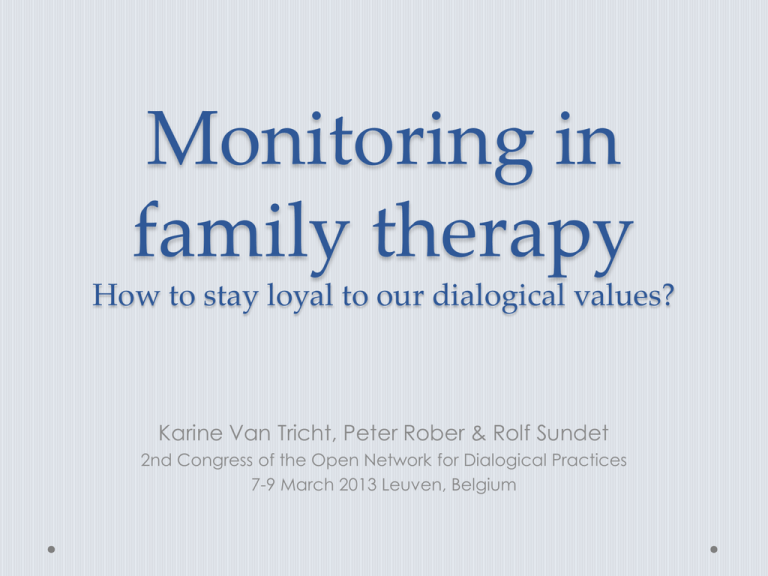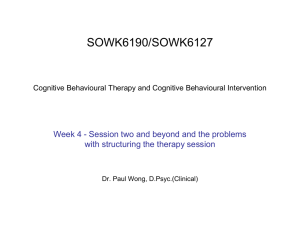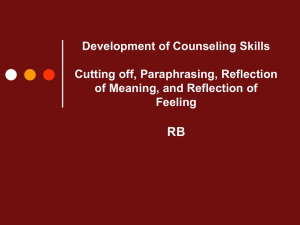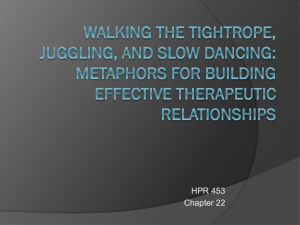here - Open Dialogical Practices
advertisement

Monitoring in family therapy How to stay loyal to our dialogical values? Karine Van Tricht, Peter Rober & Rolf Sundet 2nd Congress of the Open Network for Dialogical Practices 7-9 March 2013 Leuven, Belgium Measure of process and outcome as conversational tools: Pathways to a dialogical oriented practice of service user and therapist collaboration. Rolf Sundet Leuven, 2013 rosundet@online.no University College of Buskerud, Institute for Research in Mental Health and Substance Abuse & The Ambulant Family Section, Dept of Mental Health for Children and Adolescents, Hospital of Drammen, Vestre Viken HF. Mental Health Care anno 2013 • Neoliberal society – Market economy • Economic product • Profitability o Money o Results o Social benefit • Psychotherapy o Evidence based o Effective o Efficient • ‘To measure is to know’ atmosphere • Quality Control Systems From Evidence Based Practice to Practice Based Evidence • RCT’s & Psychotherapy o o o o Specificity & complexity Generalizability? External validity? Creativity? • RCT’s & Family Therapy = trouble in paradise o What is the diagnosis? o Complexity and specificity of treatment o Who/what is responsible for change? Monitoring: bridging the gap between research and practice • Terminology o o o o o o o o o Outcome management Routine Outcome Monitoring Routine Outcome Measurement Feedback Oriented therapy Client Directed Outcome Informed Therapy Tracking Monitoring ROMMEN QITTEN Evidence • Outcome improvement o o o o Duncan & Sparks, 2009; 2010 Reese et al., 2010 Anker, Duncan & Sparks, 2009 Duncan & Miller, 2000 • Drop-out prevention & better dose/effect ratio o Lambert, 2007; 2010 • Experienced as useful and helpful o Anker et al., 2011 • Leading to a better working alliance o Sundet 2010; 2011; 2012 Monitoring as a way of working together Creating Feedback Go with the flow Dialogical space / Culture of feedback New way of understan ding Van Tricht & Rober Integrating feedback Sources of inspiration (1) Client System Therapist System Socially, cultural, religious, spiritual Social (work, education, social contacts) The room of the therapist as a dialogical space in which a multitude of stories, opinions, emotions and perspectives come together Van Tricht, Van den Broeck, Rober, 2011; Rober 2012 Family, close friends Therapist(s), couple, parents, children Sources of inspiration (2) • QIT online (Quality Improvement in Therapy) Basic Principles Characteristics Instruments Practice based Multidimensional Psychometrics Process oriented Multimodal A-theoretical Feedback driven Flexibel Change sensitive Broad spectrum Internetbased Clinically relevant User friendly Easily available Stinckens, Smits, Rober & Claes, 2012 A qualitative study of a locally developed family based practice within Mental Health for Children and Adolescents Conclusions: Two measures, the Outcome Rating Scale (ORS) and the Session Rating Scale (SRS): • They function as intended, that is; as tools of feedback. • A surplus: They function as conversational tools, that is; they give rise and opportunity to conservational types and processes Repairing an alliance burst by means of discussing feedback Clinical conclusion The ORS and the SRS do not give answers, they are opportunities for questions The family perspective: The function of ORS & SRS as conversational tools To communicate To focus To structure To explore To tell and express To visualize To give direction to the work To discover To state areas of acceptance and change To make distinct To state thematic content To deepen The Therapist Perspective: The Function of ORS and SRS as conversational tools The scales as openings ...for conversations about feedback, progression and change ...for conversations that express experiences, meanings, and perspectives about the therapeutic work ...for conversations that create routine and structure ...for conversations characterized by the not-knowing position ...for externalizing conversations ...for conversations that bring forth a product or result Conceptual Framework QIT Family Van Tricht & Rober Specificity of integrating monitoring in Family Therapy • Instrumental level o Adult & child versions o Outcome & process • Implementational level o o o o Clear introduction In session: Apart / together Home work: Apart / together On paper or electronic • Dialogical level o Open, curious, interested and non-judgmental T attitude o Feedbackloops: how, what, when o Enactment Measurements of QIT Family [Informed Consent (Van Tricht & Rober, 2013)] Concerns Questionnaire (Van Tricht & Rober, 2013) SCORE-15 (Fay e.a., 2012; Stratton, subm. in JFT) OQ-45 (Lambert e.a., 1996) YOQ-30.2 (Burlingame & Lambert, 2001) ORS (Duncan & Miller, 2000) SRS (Duncan & Miller, 2000) (Y)CORS (Duncan, Miller & Sparks, 2003) (Y)CSRS (Duncan, Miller & Sparks, 2003) TSS(Kokotovic & Tracey, 1990; Tracey, 1989; Hafkenscheid, 2012) IMI(Kiesler, 1996; Hafkenscheid, 2012) Van Tricht & Rober Feedback CULTURE In the relationship between service user and therapist, the therapist perspective must be transparent and the service users perspective is given priority, especially in situations of no change or detrimental development In the relationship between management and therapists the perspective of managers must be transparent and the therapist perspective must be given priority in each actual case. The function of feedback is dependent upon allowing the therapists clinical autonomy in order to respond in a tailored manner to the feedback from the service users. These measures are in danger of being ruined as feedback and conversational tools if they are included in a culture of competition and control Thank you! Alliances in Couple Therapy • • • • How to define the alliance in systemic therapies? Dyadic relations / additional information? Clinical relevance when there’s so much confusion? Overall conclusion: o Positive correlation between working alliance and successful outcome o Adding one more person adds multiple relationships Muran & Barber, 2010 Alliances in Couple Therapy • Individual model of the alliance + relational dynamics (Couple Alliance Scale, Pinsof & Catherall, 1984) o Alliances between each client and the therapist • Direct self-reported alliance • Inferred alliance (guesses of the qual. & strenght of the partners’ rel. T) o Alliance between ‘clients-as-a-couple’ and the therapist o Relational (im)balances • split alliances/siding/moving toward equilibrium Muran & Barber, 2010 “An emerging quality of collaboration in relation to the necessary accomplishments, arising from a web of interacting relational dynamics” Muran & Barber, 2010 A Dialogically ORIENTED PRACTICE • including the voice, perspective, idea of the other, that is; difference is included in the dialogical. • to respond to the other and be responded by the other. • to be embodied and embedded in social practices, that is; working with and in emotional transport and relational action The practice • The use of conversational tools and the weight on dialogue gives rise to a practice where reflection and meaning making are intertwined with emotional and experiential participation of the therapist • The centrality of collaboration Collaboration Collaboration is characterized by; Mutualism (turn-taking, jointly responding to the other’s response, dialogue, conversation) Common goal Putting difference to work Family based practice ”The helpful relationship” ”The helpful participation” ”The helpful conversation” Generating collaboration (Alliance and to listen, take seriously and believe) Using professional knowledge Asking questions, giving time and structure the work Giving of oneself Understanding through participation Reformulation Fighting violation, disparagement and degradation Having many possibilities Giving and receiving feedback Publications Sundet, R. (2010). Therapeutic collaboration and formalized feedback: Using perspectives from Vygotsky and Bakhtin to shed light on practices in a family therapy unit, Clinical Child Psychology and Psychiatry, 15(1), 81-95 Sundet, R. (2011). Collaboration: Family and therapists perspectives of helpful therapy. Journal of Marital and Family Therapy, 37(2), 236-249 Sundet, R. (2012). Therapist perspectives on the use of feedback on process and outcome: Patient focused research in practice. Canadian Psychology, 53(2), 122-130 Sundet, R (2012). Patient focused research supported practices in an intensive family therapy unit: What happens? Journal of Family Therapy, (Accepted for publication). Sundet, R. (2012). Postmodern-oriented practices and implementation of patient-focused research: Possibilities and hazards. Australian and New Zealand Journal of Family Therapy (In review).









